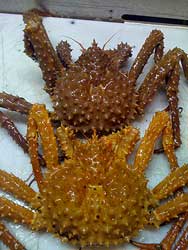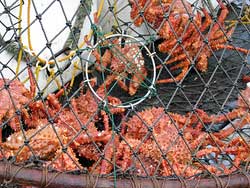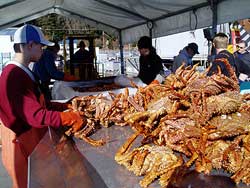
Golden King Crab Research
Southeast Alaska & Yakutat Commercial Fisheries
Golden king crab (Lithodes aequispinus)
Projects
Golden king crab onboard observer program

Observing onboard commercial golden king crab vessels was initiated during the 1999/00 season with the purpose of collecting data from management areas that were not being sampled dockside. This program currently provides the only opportunity to collect data on sublegal and female golden king crabs, and to describe precise locations and depth of capture by size and sex class. During the 2008/09 season, 6 trips were conducted in 5 management areas, and 5,505 crabs were measured.
Observers close escape rings on up to 50 pots per trip to allow them to retain females and sublegals, however, both open and closed escape rings pots are sampled. Golden king crab carapace length is measured and shell age, leg condition, and presence of parasites are visually assessed; for females, clutch fullness, and development and condition of eggs are determined as well. Chela height is measured for a subsample of males. For each pot sampled, location, depth, soak time, debris, substrate, bycatch count by species, pot condition, pot type, pot dimensions and weight, escape device, and bait are recorded.

Because the size composition data collected while observing includes prerecruit males, it helps with early detection of trends in recruitment. In addition, chela height data collected will provide information specific to Southeast Alaska on the male golden king crab size of maturity. Other data collected includes pot locations, depth, bycatch, soak time, and gear configuration. Distribution data by size and sex class could be useful for determining survey strata boundaries and methods in the future. Data on fishing methods and gear should prove useful to managers, as they assess the impacts on the fishery of proposed management measures.
Growth study
1Golden king crabs were tagged to estimate growth as the basis of a size limit. The abstract from the resulting publication (Koeneman and Buchanan 1985) states:

“A spaghetti isthmus tag was utilized to tag 899 male golden king crab, Lithodes aequispina, from commercial fishing vessels on various commercial fishing grounds of Southeast Alaska. Recaptures collected during the 1970 through 1976 commercial fisheries totaled 112, of which 45 were returned with information necessary to determine growth increments for one molt. Premolt size distribution ranged from 126 to 170 mm in carapace length. Average growth per molt was 16.3 mm, with a range of 7 to 21 mm for recaptures indicating one molt. Average time at large was 17.5 months, within a range of 10 to 33 months for one molt. Multiple molt data indicates 7 recaptures accomplished two molts, 2 recaptures accomplished three molts, and 1 recapture accomplished four molts. The largest growth recorded was 6 mm in 51 months by a recaptures with a premolt carapace length of 133 mm.”
Dockside sampling
Department personnel have sampled commercial deliveries of golden king crab dockside for carapace length, and shell condition at various ports throughout the region since 1970. Length frequency data are used to monitor recruitment trends and the relative contribution of various recruit-classes of crab. Department personnel began collecting average weight data dockside in 1975; this data provides additional insight into stock dynamics. In 1985, skipper interviews were initiated to provide an estimate of catch per unit of effort (CPUE).
Publications authored by ADF&G Staff or contractors
- 1 Koeneman, T. M., and D. V. Buchanan. 1985. Growth of the golden king crab, Lithodes aequispina, in southeast Alaskan waters (PDF 3,403 kB). Pages 281-297 In: Proceedings of the International King Crab Symposium. University of Alaska, Sea Grant, Anchorage, Alaska.
